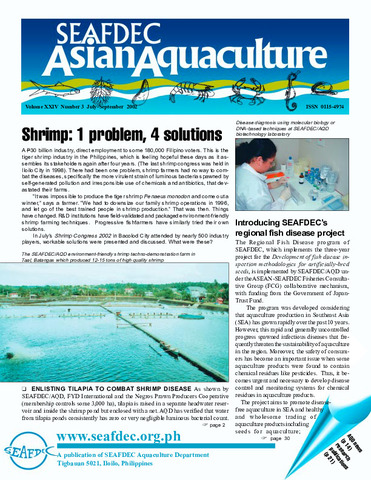Perlihatkan publikasi sederhana
Nursery and grow-out operation and management of Penaeus monodon (Fabricius)
| dc.contributor.author | Corre, Kaylin G. | |
| dc.contributor.editor | Juario, Jesus V. | |
| dc.contributor.editor | Benitez, Lita V. | |
| dc.date.accessioned | 2011-06-06T02:33:59Z | |
| dc.date.available | 2011-06-06T02:33:59Z | |
| dc.date.issued | 1988 | |
| dc.identifier.citation | Corre, K. G. (1988). Nursery and grow-out operation and management of Penaeus monodon (Fabricius). In J. V. Juario & L. V. Benitez (Eds.), Perspectives in Aquaculture Development in Southeast Asia and Japan: Contributions of the SEAFDEC Aquaculture Department. Proceedings of the Seminar on Aquaculture Development in Southeast Asia, 8-12 September 1987, Iloilo City, Philippines. (pp. 249-267). Tigbauan, Iloilo, Philippines: SEAFDEC, Aquaculture Department. | en |
| dc.identifier.isbn | 971851113X | |
| dc.identifier.uri | http://hdl.handle.net/10862/134 | |
| dc.description.abstract | The results of research on nursery and grow-out rearing of prawn conducted by the SEAFDEC Aquaculture Department for over a decade are reviewed. Different rearing facilities designed to accommodate hatchery-produced prawn fry are presented with corresponding data on growth, survival and production. Studies on stocking density, fertilization/natural food production, water management, feeds and feeding schemes and harvest/post-harvest handling are evaluated and viable technology identified. Diseases, pests and predators and other factors considered as production constraints are also mentioned. The success in hatchery operation for prawn coupled by the gradual emergence of nursery and grow-out rearing technology have triggered off a technology-dependent prawn industry. When SEAFDEC AQD was established in 1973, there were very few commercial prawn monoculture ventures in the country. Prawn pond production was mostly an incidental crop in milkfish culture. At present, various prawn grow-out techniques ranging from extensive, semi-intensive and intensive culture systems are in practice. SEAFDEC AQD focused its research on the extensive and semi-intensive culture systems which are within the reach of most farmers in contrast to the intensive system that is highly capital-intensive. There have been much work done in nursery and grow-out operations, but much remains to be done in research, among which are the development of nutritionally-efficient and low-cost feed, control of diseases, etc. | en |
| dc.language.iso | en | en |
| dc.publisher | Aquaculture Department, Southeast Asian Fisheries Development Center | en |
| dc.subject | Penaeus monodon | en |
| dc.subject | Philippines | en |
| dc.title | Nursery and grow-out operation and management of Penaeus monodon (Fabricius) | en |
| dc.type | Conference paper | en |
| dc.citation.spage | 249 | |
| dc.citation.epage | 267 | |
| dc.citation.conferenceTitle | Seminar on Aquaculture Development in Southeast Asia, 8-12 September 1987, Iloilo City, Philippines | en |
| dc.subject.asfa | stocking density | en |
| dc.subject.asfa | fish handling | en |
| dc.subject.asfa | shrimp culture | en |
| dc.subject.asfa | feeds | en |
| dc.subject.asfa | extensive aquaculture | en |
| dc.subject.asfa | fry | en |
| dc.subject.asfa | husbandry diseases | en |
| dc.subject.asfa | pond culture | en |
| dc.subject.asfa | disease control | en |
| dc.subject.asfa | survival | en |
| dc.subject.asfa | fertilization | en |
| dc.subject.asfa | aquaculture systems | en |
| dc.subject.asfa | aquaculture economics | en |
| dc.subject.asfa | intensive aquaculture | en |
| dc.subject.asfa | aquaculture facilities | en |
| dc.subject.asfa | water management | en |
| dc.subject.asfa | feeding experiments | en |
| dc.subject.asfa | parasitic diseases | en |
| dc.subject.asfa | aquaculture techniques | en |
| dc.subject.asfa | crustacean larvae | en |
| dc.subject.scientificName | Penaeus monodon | en |
Files in this item
Publikasi ini ada di koleksi berikut
-
ADSEA '87 [20]
Proceedings of the Seminar on Aquaculture Development in Southeast Asia, 8-12 September 1987, Iloilo City, Philippines





